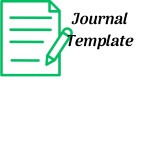Isolation and Morphological Characterization of Bacteria Degrading on Soil Contaminated by Wasted Cooking Oil
Abstract
Oil is used as an important component in human life as an energy source. The fried oil gives a delicious taste for consumption. However, the remaining cooking oil that has been cooked is discarded in the surrounding environment which is the cause of soil contamination by the oil. Thus, bioremediation is carried out to degrade contaminants with the ability of microorganisms or macroorganisms to become harmless compounds. The purpose of this research was to isolate and characterize the morphology of bacteria hydrocarbon-degrading from the environment or soil that had used cooking oil spills. The research method used was purposive sampling and descriptive qualitative. Purposive sampling is by determining where the sample to be taken has soil contaminated with used cooking oil and qualitative description is by describing the morphological characterization of the bacterial degrading isolates from the sample. The results of the research obtained that two bacterial isolates had a round shape, optically opaque, and flat edges. BCO-1 isolate has a brown color with a flat elevation and BCO-2 is white with a convex elevation. The bacteria degrading in BCO-1 isolates had a significant ability to degrade used cooking oil that was contaminated in the soil compared to BCO-2 isolates based on changes in the level of oil fluid.
Downloads
References
Al-Hawash, A.B., Dragh, M.A., Li, S., Alhujaily, A., Abbood, H.A., Zhang, X., and Ma, F. 2018. Principles of Microbial Degradation of Petroleum Hydrocarbons in The Environment. Egypt. J. Aquat. Res. 44 (2): 71–76.
Amalia, F., Retnaningsih, J., and Irni, R. 2010. Perilaku Penggunaan Minyak Goreng serta Pengaruhnya terhadap Keikutsertaan Program Pengumpulan Minyak Jelantah di Kota Bogor. Jur. Ilm. Kel.& Kons. 3 (2): 184-189.
Biswas, M., Sahoo, S., Maiti, S., and Roy, S. 2016. Isolation of Lipase Producing Bacteria and Determination of Their Lipase Activity From Avegetative Oil Contaminated Soil. International Research Journal of Basic and Applied Sciences. 1 (2): 4-7.
Cai, Y., Wang, R., Rao, P., Wu, B., Yan, L., Hu, L., Park, S., Ryu, M., and Zhou, X. 2021. Bioremediation of Petroleum Hydrocarbons Using Acinetobacter sp. SCYY-5 Isolated from Contaminated Oil Sludge: Strategy and Effectiveness Study. Int. J. Environ. Res. Public Health. 18 (2): 819.
Cappuccino, J.G., and Sherman, N. 2020. Microbiology: A Laboratory Manual 7 (Ed). USA. The Benjamin Cummings Publishing Company Inc. California.
Chung, W.K., and King, G.M. 2001. Isolation, Characterization, and Polyaromatic Hydrocarbon Degradation Potential of Aerobic Bacteria From Marine Macrofaunal Burrow Sediment and Description of Lutibacterium Anuloederans Gen. Nov. Sp. Nov. and Cycloclasticu Spirillensus Sp. Nov. Applied and Environtmental Microbiology. 67 (12): 5585-5592.
Davoodi, S.M., Miri, S., Taheran, M., Brar, S.K., Galvez, R., and Martel, R. 2020. Bioremediation of Unconventional Oil Contaminated Ecosystems under Natural and Assisted Conditions: A Review. Environmental Science & Technology. 54 (4): 2054–2067.
Elyza, F., Gofar, and Nuni, M. 2015. Identifikasi dan Uji Potensi Bakteri Lipolitik dari Limbah SBE (Spent Bleaching Earth) sebagai Agen Bioremediasi. Jurnal Ilmu Lingkungan. 13 (1): 12-18.
Galanakis, C.M. 2020. Gastromy and Food Science. USA. Academic Press.
Gargouri, B.F., Karray, N., Mhiri, F., Alaoui, S., and Sayadi. 2014. Bioremediation of Petroleum Hydrocarbons Contaminated Soil by Bacterial Consortium Isolated from An Industrial Wastewater Treatment Plant. J. Chem. Technol. Biotechnol. 89: 978–987.
Ghoreishi, G., Alemzadeh, A., Mojarrad, M., and Djavaheri, M., 2017. Bioremediation Capability and Characterization of Bacteria Isolated from Petroleum Contaminated Soils in Iran. Sustain. Environ Res. 27: 195e202.
Handrianto, Prasetyo. 2018. Mikroorganisme Pendegradasi TPH (Total Petroleum Hydrocarbon) sebagai Agen Bioremediasi Tanah Tercemar Minyak Bumi. Jurnal Sainhealth. 2 (2): 35-42.
Hossain MF, Akter MA, Sohan MS, Sultana N, Reza MA, and Hoque KM. 2022. Bioremediation potential of hydrocarbon degrading bacteria: isolation, characterization and assessment. Saudi Journal of Biological Sciences. 29 ( 1): 211-216.
Iravanian, A., and Ravari, S.O. 2020. Types of Contamination in Landfills and Effects on The
Environment: A Review Study. IOP Conf. Series: Earth and Environmental Science. 614: 012083.
Luo, Q., Zhang, J-G., Shen, X-R., Sui, X., and Fan, Z-Q. 2013. Characterization of A Novel Diesel Oil-Degrading Pseudomonas sp. Strain F4. Fresenius Environ Bullet. 22: 689–697.
Manalu, R.T., Napoleon, A., and Hermawan, A. 2016. Eksplorasi Bakteri Pendegradasi Hidrokarbon pada Tanah Terkontaminasi Minyak Bumi. Sainstech Farma. 9 (2): 39-42.
McGenity, T.J. 2014. Hydrocarbon Biodegradation in Intertidal Wetland Sediments. Curr. Opin. Biotechnol. 27: 46-54.
Moorthy, K. 2010. Isolation of Soil Bacteria for Bioremediation of Hydrocarbon Contamination. Biosci Biotech Res Asia. 7 (2).
Novianty, R., Saryono, Awaluddin, A., and Pratiwi, N.W. 2020. Bakteri Indigen Pendegradasi Hidrokarbon Minyak Bumi di Kabupaten Siak Provinsi Riau. J. Teknik Kimia. 9 (1): 34-40.
Okino-Delgado, C.H., Prado, D.Z., Facanali, R., Marques, M.M.O., Nascimento, A.S., Fernandes, C.J.C., Zambuzzi, W.F., and Fleuri, L.F. 2017. Bioremediation of Cooking Oil Waste Using Lipases from Wastes. PLoS ONE. 12 (10): e0186246.
Palanisamy, N., Ramya, J., Kumar, S., Vasanthi, N.S., Chandran, P., and Khan, S. 2014. Diesel Biodegradation Capacities of Indigenous Bacterial Species Isolated from Diesel Contaminated Soil. Journal of Environmental Health Science & Engineering. 12: 2-8.
Pi, Y., Long, M., Mutai, B., Peiyan, S., and Jinren, L. 2016. Degradation of Crude Oil and Relationship with Bacteria and Enzymaticactivities in Laboratory Testing. International Biodeterioration & Biodegradation. 106: 106-116.
Rahayu, Y.S., Yuliani, and Trimulyono, G. 2019. Isolation and Identification of Hydrocarbon Degradation Bacteria and Phosphate Solubilizing Bacteria in Oil Contaminated Soil in Bojonegoro, East Java, Indonesia. Indonesian Journal of Science & Technology. 4 (1): 134-147.
Robinson, P.K. 2015. Enzymes: principles and biotechnological applications. Essays Biochem. 59: 1-41.
Sabdaingsih, A., Budiharjo, A., and Kusdiyantini, E. 2013. Isolasi dan Karakterisasi Morfologi Koloni Bakteri Asosiasi Alga Merah (Rhodophyta) dari Perairan Kutuh Bali. Jurnal Biologi. 2 (2): 11-17.
Saimmai, A., Rukadee, O., Onlamool, T., Sobhon, V. and Maneerat, S. (2012). Characterization and Phylogenetic Analysis of Microbial Surface Active Compounds Producing Bacteria. Applied Biochemistry and Biotechnology. 168: 1003-1018.
Somboon, K., Doble, A., Bulmer, D., Baslé, A., Khalid, S., and Berg, B. 2020. Uptake of monoaromatic hydrocarbons during biodegradation by FadL channel-mediated lateral diffusion. Nat. Commun. 11: 6331.
Vitolo, M. 2020. Brief Review on Enzyme Activity. World Journal of Pharmaceutical Research. 9 (2): 60-76.
Yan, S., Qiuyu, W., Lina, Q., and Cong, L. 2013. Characterization of Oil-Degrading Bacteria from Oil-Contaminated Soil and Activity of Their Enzymes. Biotechnology and Biotechnological Equipment. 27 (4): 3932-3938.
Yolantika, H., Periadnadi, and Nurmiati. 2015. Isolasi Bakteri Pendegradasi Hidrokarbon di Tanah Tercemar Lokasi Perbengkelan Otomotif. Jurnal Biologi Universitas Andalas. 4 (3): 153-157.
Copyright (c) 2023 Imam Safir Alwan Nurza

This work is licensed under a Creative Commons Attribution-NonCommercial 4.0 International License.
All rights, title and interest in the copyright to manuscript submitted, if accepted, are hereby transferred to Maximus : Journal of Biology and Life Sciences. This includes display of the accepted article in electronic form on the internet before and/or after print publication (if any). The authors must confirm that the manuscript contains no material that would violate the copyright or any other right of any other person. The authors reserve unto themselves the following rights the right to make copies for personal teaching use, and to reproduce reasonable quantities for personal use only; the right to reuse figures and tables in articles published in other books or journals (with bibliographic reference to Maximus : Journal of Biology and Life Sciences); any proprietary rights other than copyright, including the right to any patentable subject matter contained in the manuscript and the right to deny any subsequent commercial use.







